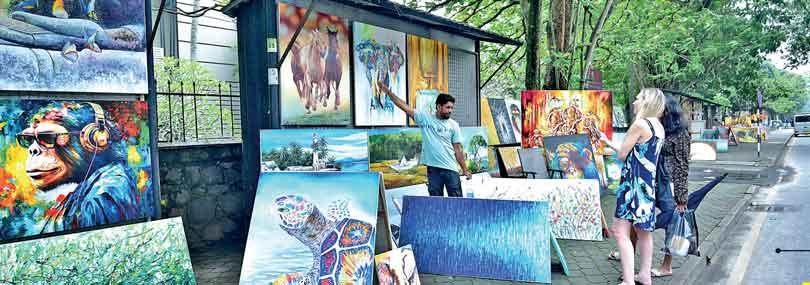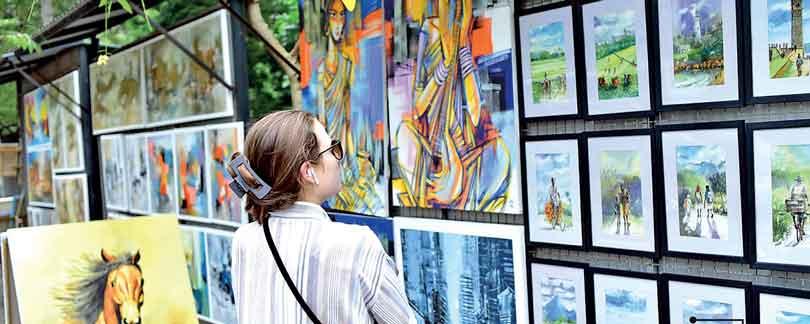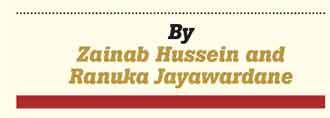Reply To:
Name - Reply Comment

Attracting locals and foreigners

A foreigner observing the portraits
pix by Samantha Perera
It has been suggested that the Government introduces a structured time allocation for tourist buses to stop at the gallery instead of simply passing by
Most Painters receive orders from hotels and other local businesses, while sales have also increased with the tourism sector witnessing a resurgence
 Initiated in 2017, Sri Lanka’s first ever permanent road-side gallery was established along the side-walks of Green Path, Viharamahadevi Park in Colombo 7 by the Government.
Initiated in 2017, Sri Lanka’s first ever permanent road-side gallery was established along the side-walks of Green Path, Viharamahadevi Park in Colombo 7 by the Government.
The primary focus of this project was to create an ‘Art Hub’ to ensure that the artists have a safe space to showcase their talents and make ends meet. The creative expression  through Local artistry must be valued and empowered. This is the core vision that paved the way for the implementation of this project. The Daily Mirror spoke to several Painters in Green Path regarding their Journey, the trials and tribulations they face and their future expectations for improvements of the road-side gallery.
through Local artistry must be valued and empowered. This is the core vision that paved the way for the implementation of this project. The Daily Mirror spoke to several Painters in Green Path regarding their Journey, the trials and tribulations they face and their future expectations for improvements of the road-side gallery.
K.A. Rohana, (42) from Gampaha is a dedicated portraitist and art vendor who has been pursuing his passion since childhood. He explained how he grew up with a natural inclination for art and has worked tirelessly to develop his own unique style of expression, influenced by his personal life experiences. Rohana previously worked as a teacher but selling art is presently his primary source of income. He prefers to explore visual narratives through the use of mixed media on canvas. These paintings have drawn the interest of foreigners, who typically roll them up for practicality and convenience when transporting them home while, affluent locals purchase his works to adorn their homes. However, Rohana faces a few arduous challenges on a daily basis besides the inevitable competition with the other vendors right beside him. He expressed his concern regarding the decrease in sales with the economic crisis which has further led to the rise in costs of canvases and paints. Rohana said that a monthly rent of Rs. 2000 has to be made for the sheltered display units to the Municipal council which is also a shared space with three others. When asked about potential improvements, Rohana further added “It would be much better if this location develops into a tourist destination with souvenir shops and so on to enhance business.”
Sales orders
Most Painters receive orders from hotels and other local businesses, while sales have also increased with the tourism sector witnessing a resurgence. S.Kulasuriya, (72) from Piliyandala is an art vendor at Green Path who sells the astounding portraits of his daughter Nayoni Manorika Kulasuriya and his Son-in–law Thusitha Godagedara. Nayoni is an Art teacher who paints to supplement her income as explained by her father who has been selling her artwork for over 18 years. “She mostly draws her inspiration from nature and prefers to rely on acrylic paints instead of oil paints which are relatively more costly. We get orders from hotels and sales have slightly risen with the tourist season coming in.” Kulasuriya further mentioned that there are approximately sixty vendors in total, including university students, though most of them display and sell their art pieces on weekends. He is optimistic about upcoming improvements and is currently looking for additional storage space to support the expanding requirements.
Time allocation
It has been suggested that the Government introduces a structured time allocation for tourist buses to stop at the gallery instead of simply passing by. Thus, Colombo 7 that neighbours several cultural landmarks including the National Museum will be able to gain a reputation as a ‘tourist hub’. Chamil Rasanga Holmes, (44) from Negombo is another art vendor who sells the paintings created by a family member, his bother Dilip Suranga Holmes. Chamil said that he has been involved in this business for over a decade and that the scenic acrylic paintings he sells are the main source of income on which they both depend on. He further added “We receive orders from hotels and other organisations but not much from the foreigners. It would be better if the Government implements a strict time allocation for tourist buses to stop at the gallery. This would give tourists more time to engage with the artwork and increase the likelihood of them making a purchase, rather than just briefly glancing at the paintings as they pass by.”
Suranga Bandara, (42) from Kurunegala has been in the art vending field for around 21 years. He recalled “I initially set up on the other side of the road, where there were no sheltered display units. However, in 2017, the new units were constructed, and we shifted here.” Suranga further explained that he sells a wide range of acrylic paintings of varying themes with prices ranging from Rs. 3,000 to Rs. 100,000, depending on the size and complexity of the work.
Active promotions
Overall, if the Government actively promotes this sector, it would not only support the painters financially but also contribute to the county’s foreign revenue. Malinga Perera, 38 from Kotugoda comes from a family of painters, with his father starting this artistic legacy 20 years ago. Since then, Malinga and his brother have continued the tradition. The thematic focus of their portraits ranges from landscapes to abstract elements. Malinga explained that he doesn’t have a specific source of inspiration; instead, he tailors his paintings according to the requests of his customers. He further mentioned that he hopes to showcase his work at exhibitions if the opportunity arises in the future.
When asked about the challenges he endures, Malinga said “It is mainly the lack of space and other essential facilities, as well as the limited awareness among foreigners about this location. Moreover, the materials required for the paintings are imported. It would greatly benefit the artists if the Government reduces the taxes on art supplies because for most artists, this is not just a side hustle, it is our livelihood.”